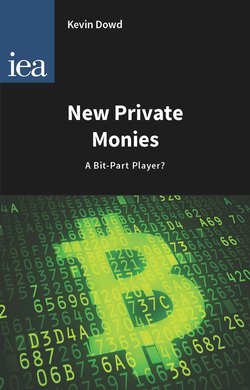Читать книгу New Private Monies - Kevin Dowd - Страница 10
На сайте Литреса книга снята с продажи.
The Liberty Dollar in exchange and as a store of value
ОглавлениеThe Liberty Dollar was specifically designed to function in parallel with the US dollar and never marketed or represented as official US currency. Indeed, its whole marketing campaign was based precisely on the fact that it was not US official currency but, rather, superior to it.9
The Liberty Dollar was backed up by a persuasive marketing pitch. To quote from one of its brochures:
Now you have a clear choice of money. Are you ready to grow and protect your money or will you continue to lose your purchasing power as the US dollar depreciates?
Just as FedEx brought choice to the US Post Office, the Liberty Dollar brings choice to the US dollar and protection for your purchasing power.
The Liberty Dollar is 100% inflation proof. It is real gold and silver that you can use just like cash where it is accepted voluntarily for everyday purchases at your grocery store, dentist or gas station…
When you are paying, ask the cashier, ‘Would you like plastic, paper or Silver?’ Then reach out and drop the Liberty Dollar in the cashier’s hand. Join the fun by simply offering the Liberty Dollar for all your goods and services.
The Liberty Dollar was highly successful and became the second most popular currency in the US. From 1998 to 2007, Liberty Dollar issues totalled up to perhaps $85m in value. Over this same period, the company issued over 350 different specimens in paper or gold, silver, platinum or copper specie that were distributed to around 250,000 customers. The Liberty Dollar was also accepted as a means of exchange. Indeed, while von NotHaus encouraged supporters to use the Liberty Dollar at ‘mom and pop’ merchants, one supporter produced a list of all the major brand names that had accepted it. The company that accepted it most was Walmart, where it was used in hundreds of their stores.10
Since the Liberty Dollar was periodically rebased to keep its value in line with the precious metals, its value rose substantially over time against the depreciating dollar. For example, as already noted, a silver Liberty medallion with a face value of $10 minted in 1998 contained one ounce of 0.999 fine silver worth approximately $5 at the time of minting and sold then for $10. However, with silver valued at about $20 per ounce, this same medallion would have an intrinsic bullion value of about $20 and would typically trade for considerably more than this on eBay. Someone who bought such a medallion in 1998 would have had an investment that more than kept up with inflation, whereas someone who held onto a $10 banknote would have seen their investment lose about half its value over the period since 1998. Moreover, investors who bought gold Liberty Dollars rather than silver ones would have benefited considerably more.
The criticism could be made that, as a store of value, the Liberty Dollar was inferior to holding, say, pure silver as the latter would not have involved the minter’s profit that led the Liberty Dollar to generally have a higher face value than its silver value. At the same time, it could be argued that, because the Liberty Dollar was not generally accepted, it was less useful than the Federal Reserve dollar as a means of exchange. In addition, because of the rebasing of the Liberty Dollars, prices would not be stable when expressed in the dollar unit of account. In response to these criticisms it should be noted that over the long run the Liberty Dollar would retain its value if the value of the dollar fell against precious metals because the Liberty Dollar would be revalued. At the same time, it had the potential to become generally acceptable and therefore be more useful than silver jewellery, trinkets, etc., as a medium of exchange. Indeed, as is noted above, it did become widely used in exchange even if it was not generally accepted.
9 The Liberty Dollar company went to great lengths to distinguish itself from official US coinage. As we have seen, they scrupulously avoided using the term ‘coin’, but they also avoided the term ‘legal tender’: to quote one of their statements, ‘[t]he Liberty Dollar has never claimed to be, does not claim to be, is not, and does not purport to be, legal tender.’ Instead, the company saw the Liberty Dollar as a form of barter – their preferred wording was ‘private voluntary barter currency’ – which people could use for exchange if they wished to.
10 Von NotHaus (2003) has a chapter devoted to the use of the Liberty Dollar as currency.
